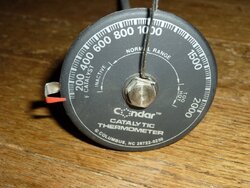After 30 years heating my house with wood, I feel almost like a complete newbie now that I have a cat stove. I love it (and will never go back to non-cat) but having to re-learn how to use a stove!
My question is, how long do most of you wait to re-engage the cat after reloading the stove with a big batch of wood? If the stove is plenty hot (stove top at 450-500), can you re-engage the cat right away? My owner's manual says 10 - 15 minutes, which seems like along time.
I'm also really wondering how differently cat stoves operate from each other. I'd love to compare directions in owners' manuals. My owner's manual says it takes 20 - 40 minutes and stove top should be 250 degrees. It easily takes 40 minutes or even more. That seems like a long time to be running the stove with no secondary combustion and it can be a bit smoky. The manufacturer told me by phone that it only needs to be 150 degrees and/or 20 minutes. (I won't say which make & model I have yet, as I'm more interested about how cat stoves work generally than discussion about a particular brand.)
So far, it seems to me that benefits of a cat stove are the long, steady burn once cat is engaged. But in start up, it seems to be smokier than a non-cat. If there is a new test method one day that includes start-up emissions, this may make it harder for cat stoves, unless they are hybrids. Thoughts?
My question is, how long do most of you wait to re-engage the cat after reloading the stove with a big batch of wood? If the stove is plenty hot (stove top at 450-500), can you re-engage the cat right away? My owner's manual says 10 - 15 minutes, which seems like along time.
I'm also really wondering how differently cat stoves operate from each other. I'd love to compare directions in owners' manuals. My owner's manual says it takes 20 - 40 minutes and stove top should be 250 degrees. It easily takes 40 minutes or even more. That seems like a long time to be running the stove with no secondary combustion and it can be a bit smoky. The manufacturer told me by phone that it only needs to be 150 degrees and/or 20 minutes. (I won't say which make & model I have yet, as I'm more interested about how cat stoves work generally than discussion about a particular brand.)
So far, it seems to me that benefits of a cat stove are the long, steady burn once cat is engaged. But in start up, it seems to be smokier than a non-cat. If there is a new test method one day that includes start-up emissions, this may make it harder for cat stoves, unless they are hybrids. Thoughts?





 But yeah, I always use the timer on my phone, just in case I space out. It's easy to get distracted. I still try to remember without the timer, though. The Fireview is about the perfect size for an average 1800 home. You'll be glad you have it when it gets cold out. You should be able to run it pretty low while still burning clean, then run on the coal heat for a while on milder days. It worked well here for 1000 sq.ft. but heat loss in this house make it more like heating 1500.
But yeah, I always use the timer on my phone, just in case I space out. It's easy to get distracted. I still try to remember without the timer, though. The Fireview is about the perfect size for an average 1800 home. You'll be glad you have it when it gets cold out. You should be able to run it pretty low while still burning clean, then run on the coal heat for a while on milder days. It worked well here for 1000 sq.ft. but heat loss in this house make it more like heating 1500.